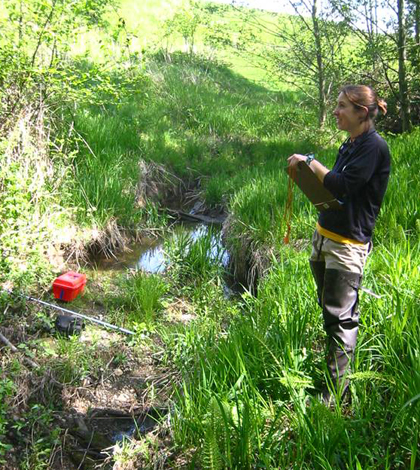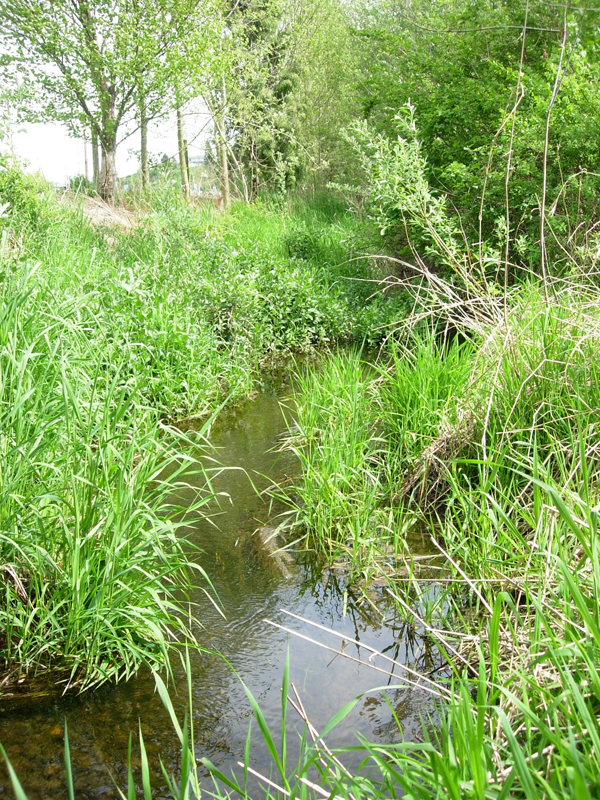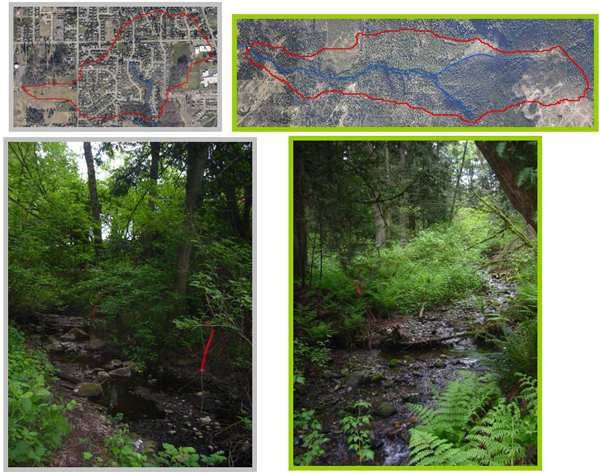Study: Restoring patchy forested riparian buffers may do little to improve stream habitat

Allison Neils sampling stream macroinvertebrates in a forested reach. (Credit: Mike LeMoine)
Promoting forested buffers along streams–either by planting new ones or preserving old ones–has become a standard restoration strategy to throw cooling shade on the water while keeping nutrients and other pollutants out. But a study from Western Washington shows that a patchwork of buffers may not do much to improve stream habitat.
Millions of dollars have been invested in restoration in Washington state alone, said study co-author David Hooper, a biology professor at Western Washington University. That has funded work towards meeting watershed-scale goals set out in guiding documents like the Salmon Recovery Plan for Endangered Species Act-listed species like Chinook salmon.
But projects like riparian buffers are generally implemented in a piecemeal-fashion because restoration groups are often limited to working on river stretches where landowners are willing to participate. That can lead to a stream with a few stretches of beneficial bank-side forests while the rest remains degraded by grazing, cultivation or urban development.
“The question we wanted to get at was: How effective is that likely to be given that a lot of that restoration is ad hoc?” Hooper said.
The study, authored by former biology graduate students Colin Wahl and Allison Neils, was recently published in the journal Freshwater Biology. The research team analyzed the insect populations and water chemistry of 12 Western Washington streams in cultivated, developed, forested and grassland watersheds. Through GIS mapping, a lot of legwork and working with landowners to gain access, the researchers came up with two study stretches on each stream–one buffered and one not.

An unbuffered reach in a “grassland” watershed.
The forested buffers ranged from leftover stands of mature growth to woodlots on agricultural land to parks. Though the study didn’t include any buffers planted through restoration projects, the advantage of looking at mature forest instead is that it gives an idea of how a best-case-scenario restoration might function a hundred years down the road.
“A lot of restoration projects are just going in now and we wouldn’t expect them to have a big effect in the first 10 years,” Hooper said. “Trees are just starting to grow and send down their roots and might not even have a closed canopy for at least another ten years, even with fast-growing species.”
Unsurprisingly, the study results showed that streams in forested or grassland watersheds were more likely than streams in developed or cultivated landscapes to support populations of sensitive insect species like caddis flies, mayflies and stoneflies. The surprise, Hooper said, was that the buffered stretches–even in urban and cultivated landscapes–weren’t any more likely than unbuffered stretches to support those insects.

The researchers investigated the biotic difference between buffered streams with similar water quality and habitat but different watershed uses. The stream on the left is in an urban watershed, and the one on the right in a forested watershed. (Composite image: Alli Neils)
The researchers also analyzed temperature, dissolved oxygen and stream substrate at each study site, and found that those factors also had little influence on insect populations. Even in urban streams where the water quality and habitat variables resembled the values found in forest streams, the macroinvertebrate communities were still degraded.
“I thought we were able to say pretty clearly that indeed this is a land-use effect,” Hooper said. “It’s not some confounding environmental variable out there from the natural world.”
Hooper said the results were a wake-up call about just how much restoration is going to be necessary to achieve watershed-scale water quality and habitat goals. A lot of restoration work so far has focused on low-hanging fruit, which is a great place to start. But further success will take a more strategic approach to carrying out restoration.
Part of that is making sure individual projects are effective, which is an area where restoration science has already made significant improvements.
“I think we’re learning a lot about how to do riparian restoration,” Hooper said. “Twenty years ago, people would plant a bunch of trees and then walk away. And the beavers would come mow them down they’d get overgrown by weeds and ten years down the road you couldn’t tell the difference. We’ve gotten better at that.”
That might include understanding where the biggest pollution sources are entering waterways and targeting those for riparian buffers. It could also mean working to reverse the piecemeal nature of restoration work, since a textbook high-quality riparian buffer’s benefits to water quality can be negated by degraded stretches upstream and downstream.
Another strategy is to make sure that buffers aren’t “holey,” Hooper said.
“In agricultural areas, you’ve got tile drains coming off the fields and the pipes of the tile drains might go right past the riparian buffers and go into the creek,” he said. “In developed watersheds you might have storm water drains that do the same thing.”
Hooper said that he hopes the results of this study and others like it can help management planners focus more on assessing whether individual restoration projects are effective. The results also should encourage a more strategic and clear-eyed approach to achieving watershed goals like those set out in the Salmon Restoration Plan.
The message certainly shouldn’t be that restoration isn’t working and those in the business should give it up.
“In a sense, we already tried quitting and it didn’t work. That’s how we got into this situation in the first place,” Hooper said. “People sort of just did whatever they wanted to to do and that’s what led to a lot of the water quality and habitat problems and endangered species problems that we have now.”
Top image: Allison Neils sampling stream macroinvertebrates in a forested reach. (Credit: Mike LeMoine)




0 comments